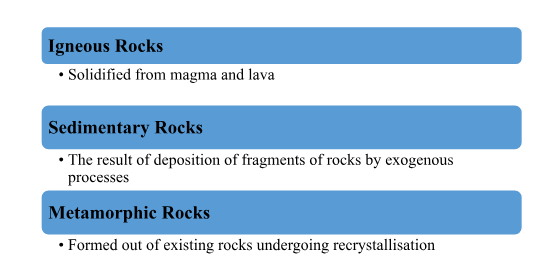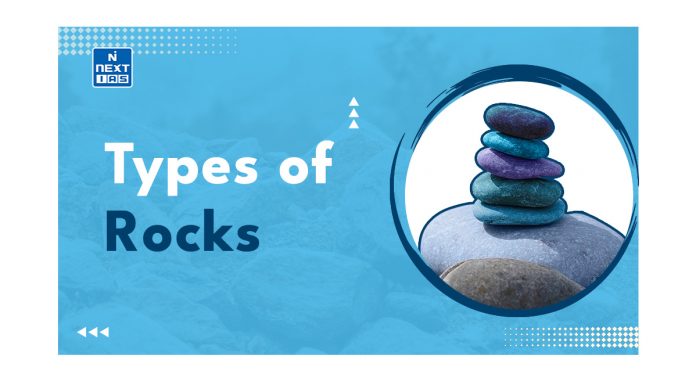The earth is composed of different kinds of elements. These elements are solid in the outer layer of the earth and hot and molten form in the interior. Thus, these elements resides in the different types of rocks.
About 98% of the total crust of the earth is composed of eight elements like silicon, oxygen, aluminium, calcium, iron, sodium, potassium, and magnesium, and the rest is constituted by titanium, carbon, hydrogen, nickel and other elements
What is Rock?
- A rock is a collection of many minerals. It may be varied in colour with its difference in softness and hardness. For instance, Soapstone is soft, Granite is hard, Quartzite can be milky white and Gabbro is black.
- It does not have a definite composition of the mineral constituents. Quartz and Feldspar are the most common minerals found in rocks.
- Thus, there are 3 different types of rocks.
Study of the Rocks
- Petrology is the study of the rocks. They study different types of rocks in all their aspects viz., texture, mineral composition, origin, structure, occurrence, alteration and relationship with other rocks.
Different types of Rocks:
- There are different types of rocks which are grouped on the basis of their mode of formation.
- They are:

What are Igneous Rocks?
- Among different types of rocks, Igneous rocks are also known as primary rocks. These rocks form out of magma and lava from the interior of the earth, they are known as primary rocks. It is formed when the magma cools and solidifies.
- When magma moves upward and cools, which further turns into solid form it is called igneous rock. The process of solidification or cooling can happen in the earth’s crust or on the surface of the earth.
- These rocks are categorized based on texture. Texture depends upon arrangement and size of grains or other physical conditions of the materials.
- If the molten material is cooled slowly (at great depths), mineral grains will be very large. Sudden cooling at the surface will result in smooth and small grains.
- Intermediate cooling would result in intermediate sizes of grains making up igneous rocks.
- The different types of igneous rocks are gabbro, pegmatite, granite, basalt, volcanic breccia and tuff.
What are Sedimentary Rocks?
- The word ‘sedimentary’ means settling. All the Rocks of the earth’s surface are exposed to denudational agents, as a result are broken up into various sizes of fragments.
- Exogenous agencies transport these fragments and deposit them. These deposits through compaction turn into rocks. Thus, this process is called lithification.
- These rocks have different layers of deposits which retain their characteristics even after lithification. Hence, the number of layers of varying thickness in sedimentary rocks like sandstone etc.
- Depending upon the mode of formation, sedimentary rocks are differentiated into three major groups:
What are Metamorphic Rocks?
- Metamorphic means ‘change of form’. Metamorphic rocks are formed under the action of pressure, volume and temperature (PVT) changes.
- It occurs when rocks are forced down to the interior of the earth by tectonic processes.
- When molten magma comes out from the crust and in contact with the rocks are subjected to great amounts of pressure by overlying rocks.
- Recrystallisation and reorganisation of materials within original rocks due to action of pressure, volume and temperature.
- The examples of metamorphic rocks are phyllite, gneiss, schist, quartzite and marble.
What do you Mean by Rock Cycle?
- These 3 types of Rocks undergo transformation, thus do not remain in their original form for long. Rock cycle is a continuous process through which old rocks are changed into new ones.
- Igneous rocks (primary rocks) and other rocks (sedimentary and metamorphic) form from these primary rocks. Igneous rocks can be transformed into metamorphic rocks and sedimentary.
- The fragments particles out of igneous and metamorphic rocks form into sedimentary rocks. Sedimentary rocks itself can turn into fragments of particles and then it can become a source for formation of sedimentary rocks.
- The crustal rocks once formed carried down into the interior of the earth (mantle) through subduction process (due to plate convergence).
- Further, the same melt down due to rise in temperature in the interior and turn into molten magma, a source for igneous rocks.
Conclusion
The transformation of different types of rocks can occur in various ways. For instance, Igneous rocks can undergo a change and become Metamorphic rocks, Metamorphic rocks can transition into Sedimentary rocks, and Sedimentary rocks can transform into Igneous rocks. Additionally, Igneous rocks can also change into Sedimentary rocks, and Sedimentary rocks can further convert into Metamorphic rocks.
Interestingly, all these different types of rocks have the ability to revert back to their original form. Moreover, any type of rock has the potential to transform into another type through processes like weathering, erosion, melting, cooling, and the application of heat and pressure. Over time, these three processes have collectively contributed to the formation of the rock cycle.









